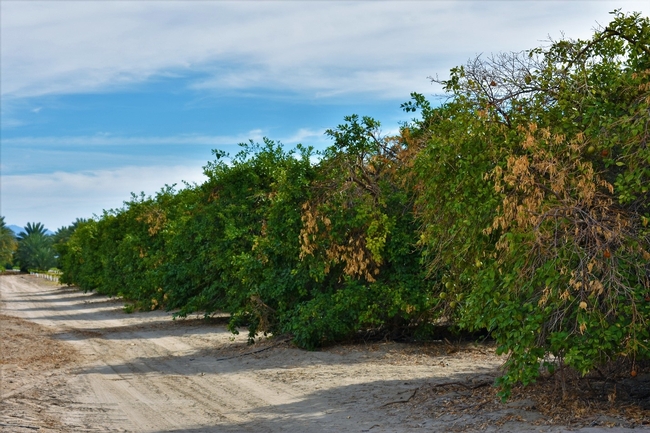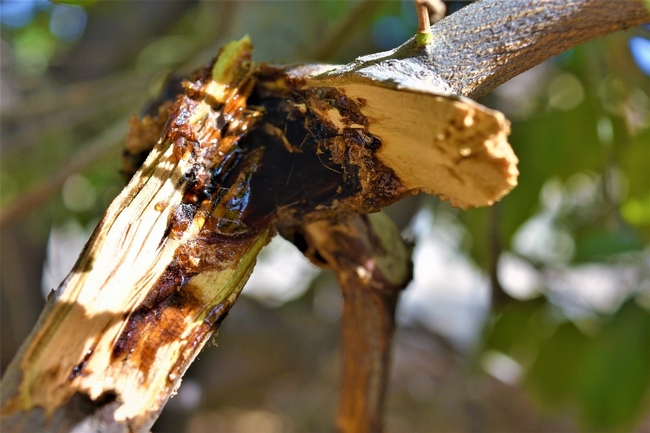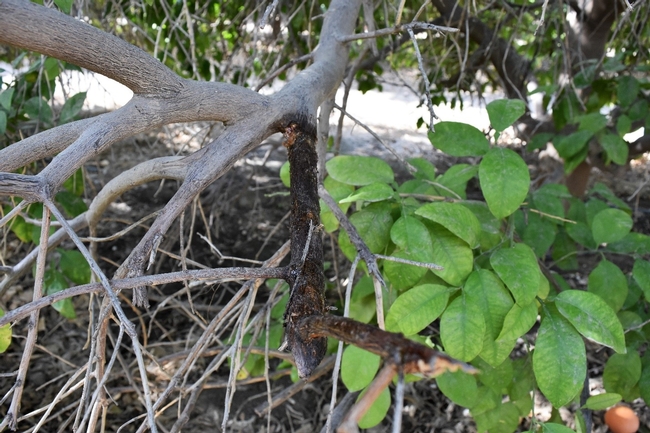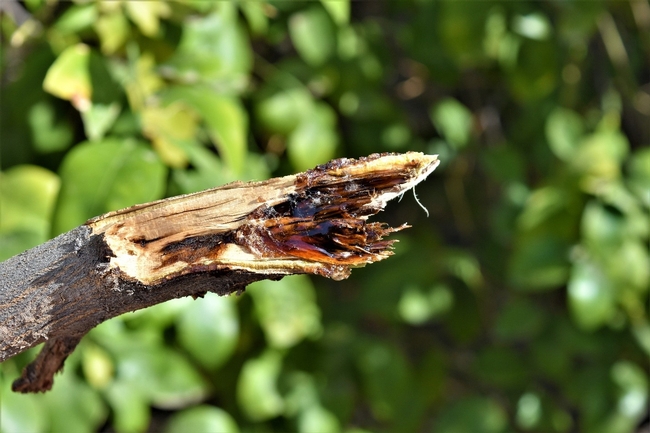
Posts Tagged: dieback
Case Study: Branch Canker and Hendersonula Diseases Troubling Growers in the Desert
In the fall of 2016 growers in the Coachella desert have been experience very puzzling symptoms on their grapefruit trees. One incident, symptoms the tree had gumming oozing from the branches (Fig. 1). Usually if it were oozing from the stump it would be a root disease such as Phytophthora spp. After photos and branch samples were taken to the Plant Pathologist at University of California, Riverside, Dr. Akif Eskelan, results determined that the trees had branch canker and Hendersonula Disease.
Symptomology
Infection by Nattrassia mangiferae (Hendersonula toruloidea) causes bark cracking and peeling or dead bark that remains tightly attached to dead limbs. Black, sooty growth may develop beneath infected bark. Brownish moist areas appear on limbs during the first stages of disease, then the bark in these areas cracks or peels away revealing black masses of fungal spores (Fig 4.). In advance stages, the injured limbs may “bleed” profusely, oozing a sap like sticky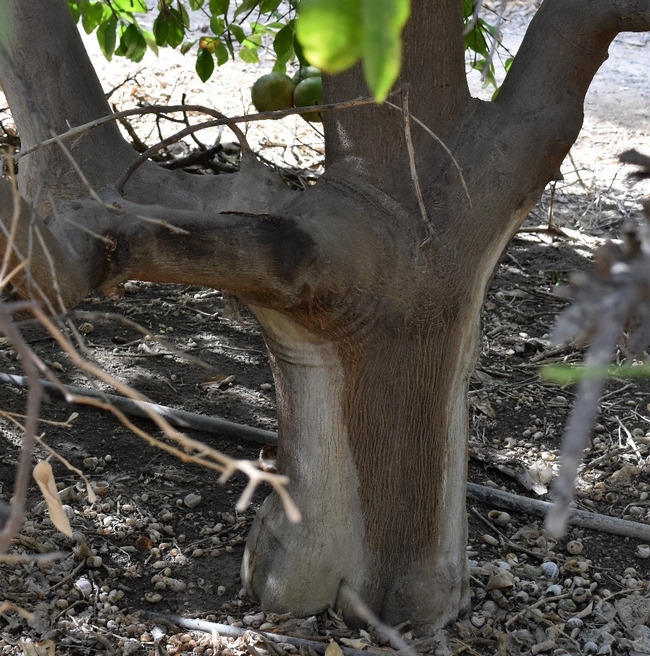
Management
Trees weakened by a disease, water stress, nutritional deficiencies, excessive pruning/mechanical damage create a are more susceptible. As many of these stressors can cause a tree to get sunburned and creates wounds that can serve as infection sites for this pathogen. Prevent sunburn by maintaining vigorous canopies through best management practices http://fruitandnuteducation.ucdavis.edu/generaltopics/ . Proper irrigation, fertilization, pruning, and pest control. Look for symptoms annually right after harvest while there are still healthy leaves on trees. Remove diseased limbs, cutting back to a lateral branch into healthy wood that shows no discoloration. Burn all infested wood, do not chip and use infected wood as mulch.
Additional Resources can be found at:
http://eskalenlab.ucr.edu/handouts/desertdieback.pdf
How to Attract an Ambrosia Beetle that Attacks Avocado and Sycamore
There's a lot of work being done in Florida on a pest/disease complex like we have here with Shot Hole Borer and Fusarium fungus – Fusarium Dieback. This hits avocados and a lot of other native trees like sycamore, willow and coast live oak. Some of the success in Florida may be applicable and we are working with their researchers there to adapt some of the techniques here.
Redbay ambrosia beetle, Xyleborus glabratus, is a wood-boring pest that has now invaded nine states in the southeastern United States. The beetle's dominant fungal symbiont (Raffaelea lauricola) is phytopathogenic, inducing laurel wilt in trees within the family Lauraceae. Members of the genus Persea are particularly susceptible to the lethal disease, including native redbay (P. borbonia) and swampbay (P. palustris), as well as commercial avocado. Cubeb oil lures are the current standard for detection of X. glabratus, but recently eucalyptol and a 50% α-copaene oil have been identified as additional attractants. This study used a combination of choice bioassays, field cage release-and-recapture assays, and a 12-week field trial to compare efficacy of eucalyptol and copaene lures relative to commercial cubeb lures. In addition, gas chromatography (analyzer for volatiles) was used to quantify emissions from lures field-aged for 12 wk. In field cage assays, copaene lures recaptured a higher percentage of released beetles than cubeb lures. In the field test, cubeb lures captured fewer beetles than copaene lures, and lowest captures were obtained with eucalyptol lures. Both copaene and cubeb lures were effective in attracting X. glabratus for 12 weeks, but field life of eucalyptol lures was only 4 weeks, consistent with the quantification of lure emissions. Results suggest that the 50% α-copaene lure provides the best pest detection currently available for X. glabratus.
So why is this important? For one, it will serve as a tool for more effectively monitoring the presents of the beetle. But more importantly, it might be used as a lure to attract them away from trees. Fool them into going somewhere else, like to die.
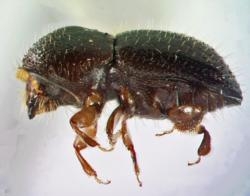
shot hole borer
Avocado Dieback – Blight vs. Phytophthora vs. Lack of Light
When you see dieback in an avocado it could be due to several reasons, and here are three very common causes of dieback, one of which has been especially common when there is little rain. The first major cause of dieback is an overgrown tree where there is no light that penetrates into the canopy. Branches with leaves in a darkened interior will naturally shut down and dieback, leaving these twiggy dried out branches. This is a natural process whereby the tree just gets rid of leaves that are not performing.
Another cause of dieback is our old friend Avocado Root Rot, Phytophthora cinnamomi. This causes dieback, also called “stag horning” because of the dead branches standing out from the surrounding canopy. This is normally accompanied by a thinning canopy with smaller, yellow leaves and a lack of leaf litter because of lack of energy. It's also hard to find roots and if they are found, they are black at the tips and brittle.
http://www.ipm.ucdavis.edu/PMG/r8101311.html
The third major cause of dieback is a result of water stress. This shows up with low water pressure, at the top of the hill where the most wind occurs, where a sprinkler gets clogged, when the irrigation schedule is not meeting tree's needs or when there is not adequate rainfall to get sufficient leaching. And after four years of drought, this is very common. This appears as dead spots in the canopy, a branch here and there where the leaves have died and are still hanging. It's been called “salt and pepper” syndrome, because it can have a few branches here and there that have died back while the rest of the canopy is normal, the leaves are normally sized and green. In young trees, in severe cases, the fungus that causes this blight can work its way down to the graft union and kill the tree. In mature trees, it just causes an unthrifty look to the tree. Although we have always seen this problem in avocado orchards, this has become a very common affliction in orchards these last few years
http://www.ipm.ucdavis.edu/PMG/r8101311.html
1) Lack of light dieback
2) Phytophthora cinnamomi dieback
3) Stem and Leaf Blight

lack of sun

root rot vs healthy

stem blight
The state of Dothiorella canker on avocado in California
Branch and trunk canker on avocado was formerly attributed to Dothiorella gregaria, hence the name Dothiorella canker. So far Botryopshaeria dothidea (anamorph: Fusicoccum aesculi) is the only known species causing Dothiorella canker on avocado in California. Symptoms observed on avocado with Dothiorella canker include shoot blight and dieback, leaf scorch, fruit rot, and cankers on branches and bark.
However, recent studies based on DNA analyses suggest greater species diversity of this pathogen group than based on morphological characteristics alone. Thus far, multiple species of Botryosphaeriaceae have been found to cause the typical Dothiorella canker (Fig3.) and stem-end rot (Fig 5) on avocado in California. Percent recovery of Botryosphaeria spp. based on morphological characters ranged from 40-100% in Riverside county, 42-53% in Ventura county, 33% in Santa Barbara county, 60% in San Diego county and 32-60% in San Luis Obispo county.
According to preliminary results from a continuing survey throughout avocado growing areas of California, multiple species of Botryosphaeria (Neofusicoccum australe, B. dothidea, N. luteum, and N. parvum) were found.
Pycnidia (overwintering structure) of Botryosphaeriaceae species were also observed on old diseased avocado tree branches. Sequenced rDNA fragments (ITS1, 5.8S rDNA, ITS2, amplified with ITS4 and ITS5 primers) were compared with sequences deposited in GenBank.
Pathogenicity tests were conducted in the greenhouse on 1-year-old avocado seedlings, Hass cv., with one randomly chosen isolate from each of the Botryosphaeriaceae species noted above. Four replicate seedlings were stem-wound inoculated with a mycelial plug and covered with Parafilm. Sterile PDA plugs were applied to four seedlings as a control. Over a period of 6 months, seedlings were assessed for disease symptoms that included browning of leaf edges and shoot dieback. Mean vascular lesion lengths on stems were 64, 66, 64, and 18 mm for B. dothidea, N. parvum, N. luteum, and N. australe, respectively. Each fungal isolate was consistently reisolated from inoculated seedlings, thus completing the pathogenicity test. To our knowledge, this is the first report of N. australe, N. luteum, and N. parvum recovered from branch cankers on avocado in California.
These results are significant because Botryosphaeriaceae canker pathogens are known to enter the host plant through fresh wounds (pruning, frost, and mechanical). With high-density planting becoming more common, which requires intensive pruning, the transmission rate of these pathogens could increase in California avocado groves. The Eskalen laboratory is currently investigating control measures for dothiorella canker and stem-end rot pathogens.
Branch dieback and trunk canker caused by the fungus

Dothiorella branch dieback

Dothiorella canker on trunk

